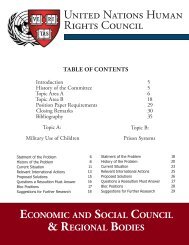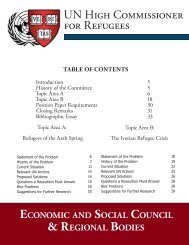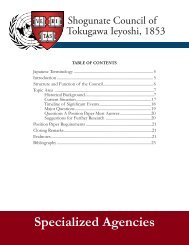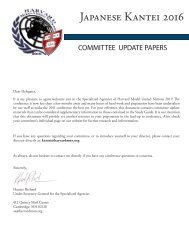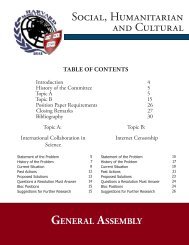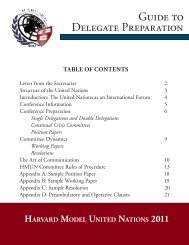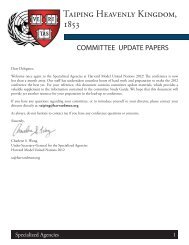World Trade Organization - Harvard Model United Nations
World Trade Organization - Harvard Model United Nations
World Trade Organization - Harvard Model United Nations
Create successful ePaper yourself
Turn your PDF publications into a flip-book with our unique Google optimized e-Paper software.
<strong>World</strong> <strong>Trade</strong> <strong>Organization</strong><br />
West & Central Africa<br />
West and Central Africa contains many land-locked,<br />
low-income, and economically stagnant countries that<br />
have struggled to integrate into the world trading system.<br />
Due to political instability, many countries have been<br />
recovering from decades of civil war and face severe<br />
challenges rebuilding institutions and governments.<br />
Economically, this region is among the poorest in<br />
the world. The region’s economy heavily depends on<br />
commodity exports, with 75% of all exports being oilrelated.<br />
The lack of diversification in exports makes the<br />
region especially vulnerable to volatile prices in oil. To<br />
make matters worse, a combination of weak physical and<br />
technological infrastructure, deadlocked bureaucracies,<br />
and weak private sectors prevent these countries from<br />
reaching their growth potentials. 21<br />
The area faces low integration in the global economy.<br />
Most countries in the region do not yet have effective<br />
strategies for developing trade with developed nations<br />
and have minimal understanding and awareness of the<br />
WTO and the rules of the international trading system.<br />
Thus the challenge lies in how to raise awareness of<br />
the need for regional and global integration of these<br />
economies.<br />
Another challenge for the region is building<br />
productive trading capacity. Only a few state-owned<br />
large corporations in the mining sector and a few Small<br />
and Medium Enterprises (SMEs) dominate the economy.<br />
Extremely high taxes and stringent government<br />
regulations discourage entrepreneurship and innovation<br />
while lax regulations enable the export of low quality<br />
goods.<br />
North Africa<br />
Case Study: Bananas in the Caribbean<br />
The European Union (EU) introduced the Common<br />
<strong>Organization</strong> of the Market in Bananas in 1993 to<br />
change the tariff/quota regime for banana imports<br />
to a tariff only regime. This increased competition for<br />
traditional Caribbean exporters of banana from newer<br />
African, Caribbean, and Pacific (ACP) banana producers<br />
like Cameroon and the Ivory Coast. Due to this trade<br />
liberalization reform and reduction in trade barriers,<br />
banana exports from the Caribbean islands fell as much<br />
as 50%.<br />
In order to aid the 12 traditional ACP banana<br />
suppliers (which were Belize, Cameroon, Cape Verde,<br />
Côte d’Ivoire, Dominica, Grenada, Jamaica, Madagascar,<br />
Saint Lucia, Saint Vincent and the Grenadines, Somalia<br />
General Assembly<br />
and Suriname), the EU adopted the Special Framework of<br />
Assistance for Traditional ACP (SFA). The SFA provided<br />
financing programs to help countries develop production/<br />
marketing strategies, obtain market intelligence, and<br />
create policies promoting the diversification of the<br />
products. Funding for diversification programs grew from<br />
about 12% of the total funding in 1999 to about 64%<br />
in 2004. Although the SFA was a well crafted agreement,<br />
it did not reach its potential due to poor allocation<br />
system. The allocation system should have helped smallscale<br />
banana farmers that would have dropped out of the<br />
banana market since the small scale of their production<br />
meant that they were especially sensitive to the drop in<br />
international prices that resulted from the elimination of<br />
the quota by the EU. 22<br />
Numerous banana farmers in St. Vincent abandoned banana<br />
cultivation. Those who stayed in production were mainly fair trade<br />
producers.<br />
Case Study: One Village One Product Initiative<br />
One successful example of a program that stimulated<br />
the local economy and made it into an integral part of<br />
a country’s export is Japan’s “One Village, One Product”<br />
(OVOP) strategy. The objective of OVOP is to empower<br />
rural communities so that they can use their comparative<br />
advantages in local crops to expand, brand, and export<br />
them for economic growth. OVOP’s origins stem from<br />
the Oita Prefecture in Japan. Financing and agricultural<br />
recommendations by the national and local governments<br />
promoted the production of select goods with high<br />
added value, resulting in each village in Oita focusing<br />
on a single, competitive, staple product such as shiitake<br />
mushrooms and kabosu. In all, the program has created<br />
a total of 810 products ranging from vegetables to meat<br />
and fruits, generating a revenue of approximately $US<br />
1.15 billion in 2004. 23<br />
9





